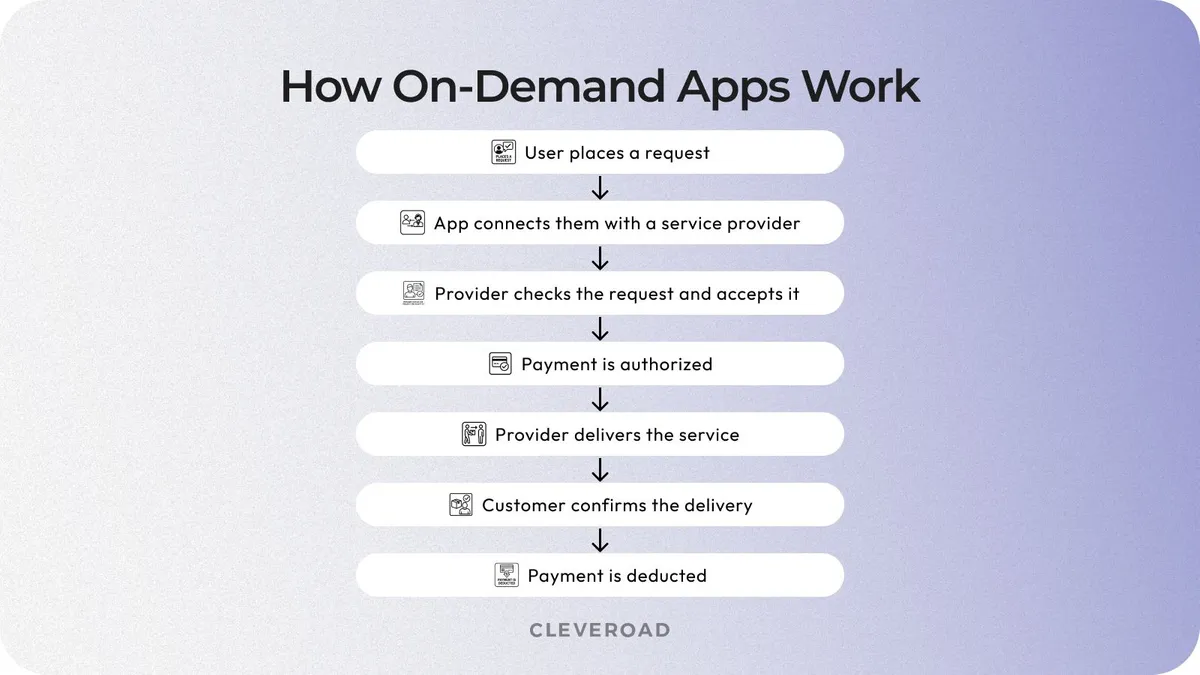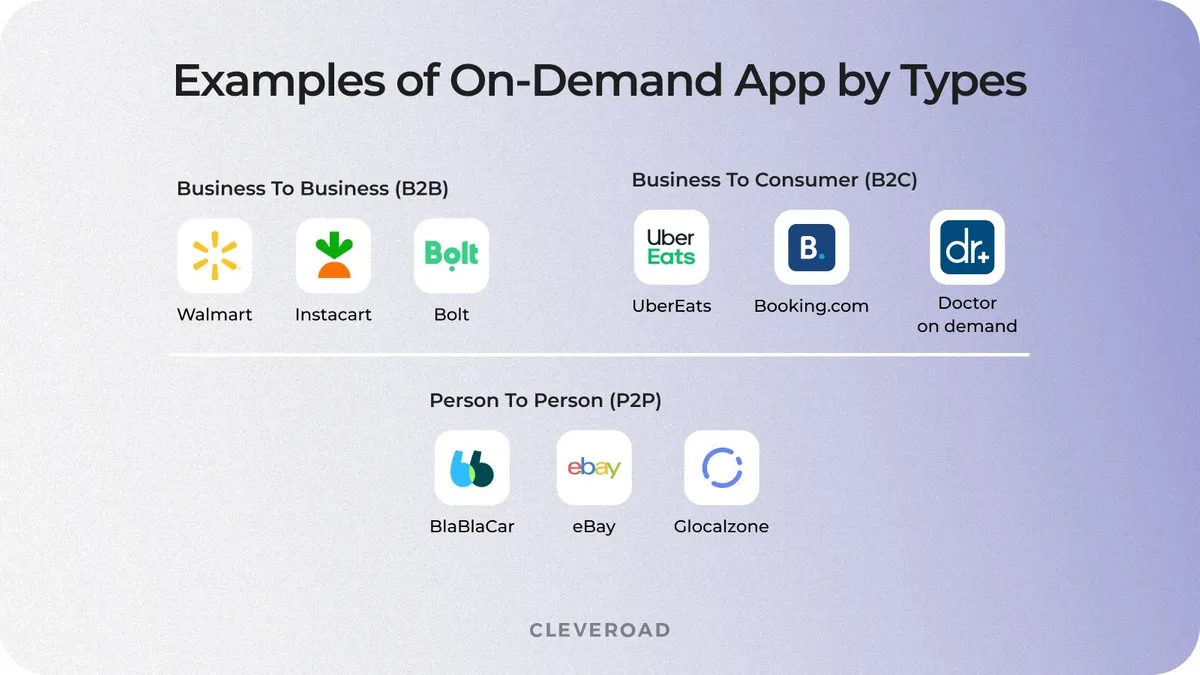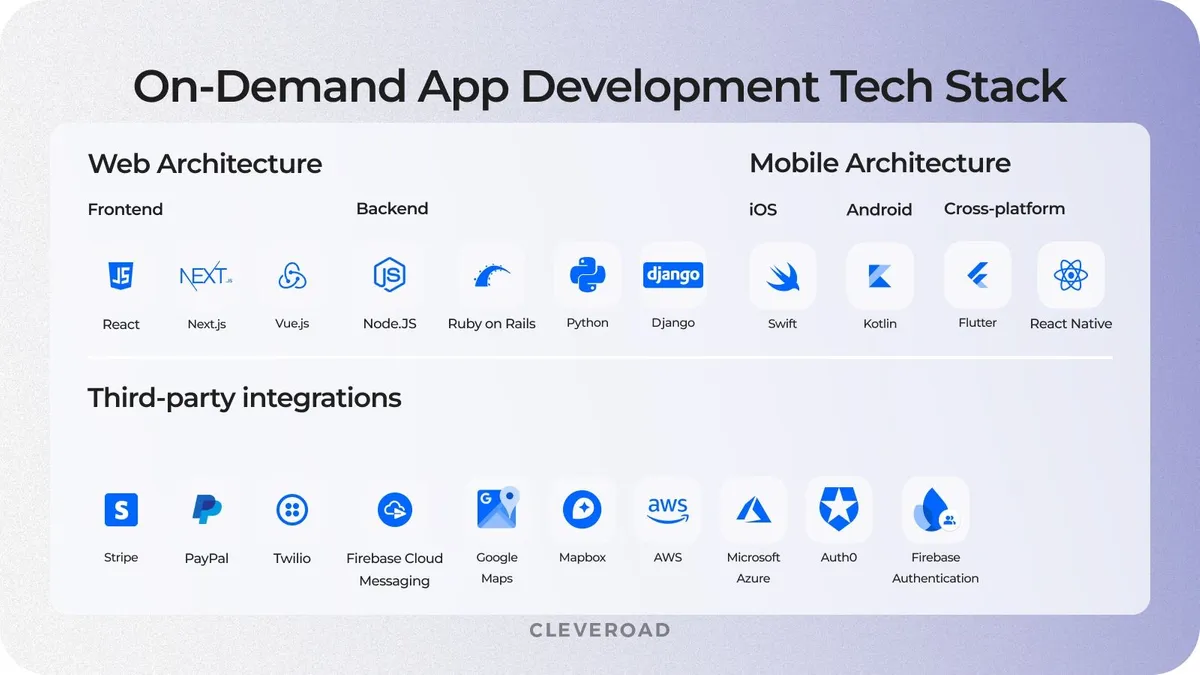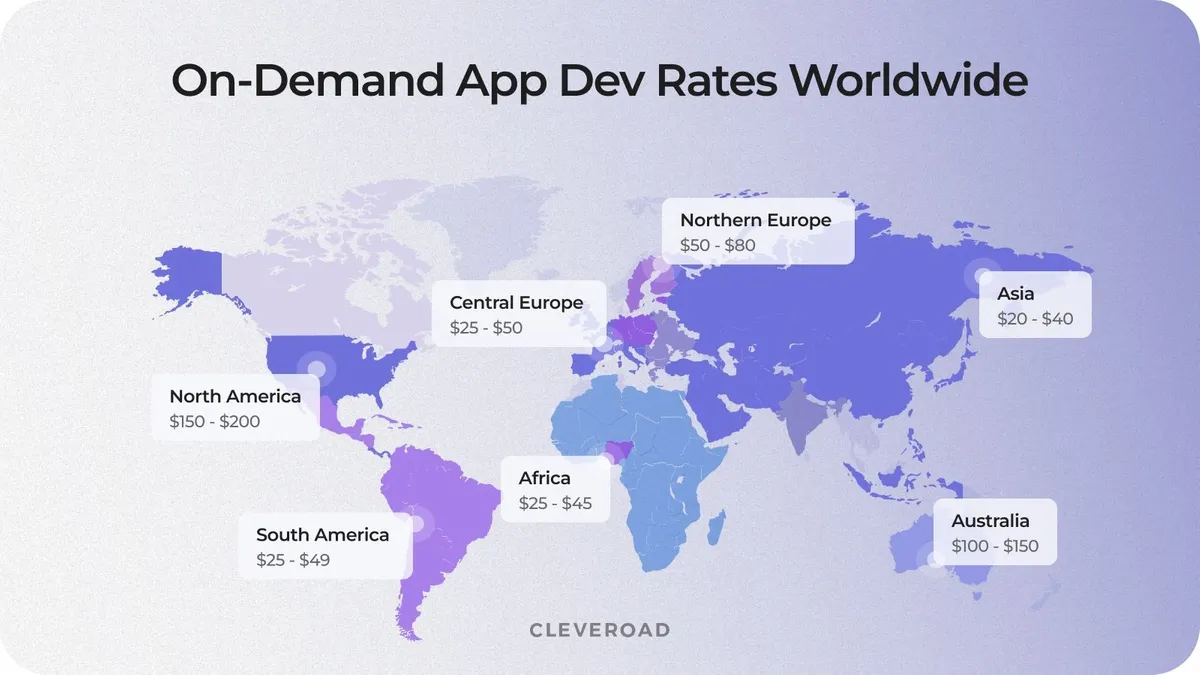On Demand App Development: Comprehensive Overview for 2026
Updated 22 Sep 2025
19 Min
11427 Views
On demand service app development is reshaping industries: today, it’s hard to imagine a field unknown to the on-demand market. The variety of services, speed, convenience, and quality make these apps popular and widely used around the globe. But behind everything, there's a fast, reliable, and easy-to-use platform.
At Cleveroad, we’ve helped companies design and launch multiple on-demand platforms across logistics, healthcare, and retail, so in this guide, we’ll share what really works. You’ll learn about on-demand service app development aspects, from types of software to must-have features, and how to build an app that delivers measurable results.
Key steps to build an on-demand app are:
- Research market and users
- Find the right tech partner
- Select features and MVP scope
- Pick the tech stack
- Go through development and testing process
- Release, update and promote
All these stages of on demand apps development have their own peculiarities and best practices. The number of steps can vary depending on your goals and project requirements, and we’ll cover them one by one in detail below.
What Is an On-Demand Service App?
An on-demand service app is a digital platform that connects customers with businesses or service providers instantly, making it easy to request and receive services in just a few clicks.
Popular on-demand app models examples include:
- Uber for ride-hailing
- Glovo for food and goods delivery
- Doctor on Demand for telemedicine
These apps solve users' major and minor everyday problems. For now, there are on-demand platforms in beauty, education, healthcare, taxi and cargo delivery, food delivery, and many other fields. And we can get all that beauty just by a few finger taps.
What makes the model sustainable is its monetization: the platform charges a fee for each transaction while giving both customers and providers real value. Users save time by getting services quickly, and providers gain access to a broader audience without spending on costly promotion. This win-win approach is what drives the rapid adoption of on-demand apps worldwide.
Here’s how on-demand apps like Uber work:

Operating mechanism of on-demand apps
What is the potential of on demand app development
The on-demand economy has shifted from a niche model into a mainstream way of consuming services. The global on-demand market is projected to reach $335 billion by the end of 2025, driven by millions of users who value speed, convenience, seamless experiences, and digital-first access to daily needs (source: Insurtech Insights).
There are several reasons for this surge of on-demand solutions:
- Lower costs. On-demand mobile application development often delivers lower prices compared to traditional providers. For example, the ride-hailing market has grown to over $120 billion in 2024, with projections to increase to $480 billion by 2032, according to Fortune Business Insights. This growth is fueled by competitive pricing compared to taxis.
- Availability. With smartphones everywhere, on-demand services become accessible anytime, anywhere, and to virtually anyone.
- Adjustment to preferences. Businesses strive to meet user expectations by delivering their goods and services within hours rather than days. As to YouGov data, more than 28% of Americans now use food delivery apps weekly, highlighting the shift to faster fulfillment.
- Various payment methods. On-demand apps commonly integrate Stripe, Braintree, PayPal, and even cash-on-delivery options.
- Minimum efforts. Users can save payment and delivery details, avoiding repetitive input. A recent Morgan Stanley Research AlphaWise survey confirms that convenience remains a top priority, making on-demand apps especially attractive thanks to features like one-tap orders, saved payment details, auto-filled delivery information, and so on.
- Variety. Dozens of on-demand apps exist in every category, from babysitting to beauty services, ensuring each user finds a suitable option.
These figures make it clear: on-demand app development is no longer optional for businesses in competitive markets. Companies that invest in scalable, user-centric platforms now can capture long-term customer loyalty and secure their share in a rapidly expanding economy.
Types of On-Demand Service Apps
While planning an on-demand mobile app development, it’s vital to define what kind of solution you want to deliver. This will determine the targets and feature set of your future application.
Based on the users involved, on-demand apps can be divided into three groups:
- Business-to-Business (B2B) on-demand application development
- Business-to-Consumer (B2C) on-demand app development
- Person-to-Person (P2P) on demand application development
Business to business
Business-to-business on-demand service applications connect one enterprise to another. They involve providers, suppliers, Maintenance Company, etc. Like B2C customers, B2B clients expect high levels of customer satisfaction, and on demand mobile app development is an excellent way to deliver a seamless experience. For instance, Walmart’s suppliers employ a group of mobile applications that are linked to Walmart’s supply chain platform.
Business to consumer
Enterprises start on demand application development to distribute their goods or services. The user only needs to download the finished app to find the required services or order products. These can be applications that cater to single providers (e.g., specific restaurants) or multiple providers distributing their services or products on a single platform. For example, the Starbucks app enables users to jump the line by ordering and paying for coffee in advance or having their order delivered right to the office.
Person to person
P2P on-demand service app development allows your users to exchange goods or services and make transactions through a specialized platform. For example, BlaBlaCar helps users to seek co-travelers. Users can offer or find rides online by entering trip details, such as points of departure, arrival dates, etc.
Once the user seeks the perfect ride, they can book a seat, and the contact info is sent to drivers for further clarification. Another good example is the Glocalzone. The platform connects travelers with people aiming to purchase goods from a different country. It allows travelers to earn extra money while reducing the costs of importing hard-to-find products for a buyer.

Examples of on-demand application by types
On Demand App Development Across Various Industries
As you can see, there are quite a lot of spheres on-demand services come suitable for. Taxi, meal delivery, dog walking, babysitting, laundry pick-up: on-demand applications seem to be taking care of everything. So let’s see how various industries make the use of on demand service app development and consider leading apps in each.
Taxi services
The taxi and transportation field benefits the most from on-demand service apps development. No wonder big players like Uber or Lyft have changed the game forever. Now, the taxi apps let customers book a car in just a few minutes. All they have to do is set their destination and wait for the cab to arrive. The driver will get a ride request and, if everything's arranged, come to pick their passengers.
Today's on-demand taxi apps offer many new features, but the must-haves are:
- Map and GPS navigation that helps customers catch nearby taxis
- Communication channels between riders and drivers
- Advanced feedback system (rates and reviews)
The most well-known taxi apps apart of Uber and Lyft are:
- Flywheel
- Curb
- Free Now
By the way, we've also worked on a P2P on-demand app called MoveUp. It’s a taxi service just like Uber or Lyft, but targeted both at regular people who need a ride and at those with specific medical needs, bulky items, parents with children, etc.
We've created a brand-new on-demand ridesharing app with a sophisticated filtering system and offline driver's validation. Moreover, the app also includes complex payment capabilities with a free-ride option, allowing our customers to stay apart from the overused Uber business model.
As a result, our client received a scalable and flexible platform with integrated GPS technology, Stripe, and other features that helps people find the best transport option meeting their needs.
- Feel free to examine our MoveUp case study in more detail
Here’s what our client, John Salmon, founder at Unified Potential, Inc.dba MoveUP says about cooperation with Cleveroad:
John Salmon, founder at Unified Potential, Inc.dba MoveUP says about about cooperation with Cleveroad.
Household chores
House cleaning, repairs, dog walking and many other everyday tasks take lots of time. And for those who need help with household chores, for example, washing clothes, laundry app development is a perfect way out.
For example, if you have a leakage issue at home, you just post a request on the app and a nearby plumber fixes it in no time. These platforms help with fixing carpentry problems, home appliances, etc.
Apps that have gained popularity in this niche include:
- TaskRabbit
- Merry Maids
- Thumbtack
Delivery apps
On-demand delivery app development is no longer limited to meals from nearby restaurants: today, users expect to order almost anything with just a few taps. This shift is powered by on-demand mobile app development, which gives users speed, choice, and convenience, while businesses get access to new revenue streams. The model has proved especially effective because demand app development companies and on-demand app developers can now create scalable app solutions that integrate multiple product categories into a single platform.
Companies like Glovo and Instacart have already shown how one platform can cover diverse needs, becoming leading on-demand players by offering everything from food to pharmacy items. For new entrants, partnering with an experienced app development team ensures that they get tailored app development solutions aligned with market demand.
Key advantages of on-demand app solutions for delivery services:
- Ability to cover multiple categories in one app (meals, groceries, medicines, flowers, gifts, and more)
- Flexible scheduling options and real-time order tracking
- Faster scaling with proven on-demand app solutions
- Seamless user experience thanks to integrated payments and order history
- Opportunities for retailers and service providers to reach wider audiences
Learn how to build an app like Uber Eats in our detailed guide exploring features, cost, and tools
Logistics
Logistical on demand service app development have increased in popularity due to cross-border e-commerce activities and millions of diversified goods that should be handled properly to ensure a good delivery experience. Such applications bridge the gap between shippers and carriers.
It enables users to track the goods in real-time, compare the carrier rates, scan the goods to collect item-related data, get electronic proof of delivery, receive instant confirmed bookings, and much more.
The most prominent examples of on-demand platforms in the field are:
- Uber Freight
- Onfleet
Healthcare
On-demand medical apps connect patients with doctors. So users can talk to their physicians one-on-one when they need help. And just like during an ordinary visit, doctors make recommendations.
Of course, no on-demand mHealth app can take care of serious disease, and patients can’t get tested or properly examined without going to a hospital. But a plain consultation is something on-demand service apps can cope with.
The best on-demand healthcare apps are:
- Doctor on Demand
- Pager
Learn about all aspects of doctor on-demand app development process, features, cost, and more
How to Start an On Demand Application Development in 6 Steps
Now, let’s discuss making this type of app in more detail. As an on demand mobile app development company, we’ll find out the appropriate steps you should take to design a client-centric product.
Step 1. Research market and users
One of the most common mistakes is when businesses focus only on technology and coding, forgetting that top on demand app development always starts with a clear understanding of the idea and audience. While development ensures that the app runs smoothly, it’s thorough market and user research that reveals who your customers are, what pains they have, and how your app can solve them. Skilled demand app developers rely on this data to design experiences that feel intuitive and valuable.
Comprehensive research forms the foundation of any strong demand app development solution, ensuring that the product is not just functional but also relevant, competitive, and user-friendly.
Here are the main research tips:
- Learn about customers. Online behaviors, hobbies, pains and needs – the more you know about future users, the more attractive app you can build.
- Concentrate on unique functions. In such a highly saturated market, the most effective way to attract customers is by delivering a distinctive and well-differentiated solution. No one wants to download on-demand delivery app clones with the same features.
- Don't try to please everyone. Even if you do, the app won't be capable of solving all users' issues. Focus on the majority. Continuous updates aimed to serve all needs cost a lot, and there's no guaranteed profit returns.
Step 2. Find the right tech partner
Choosing the right vendor is one of the most important steps in on-demand mobile app development. Whether you’re building a booking app, grocery delivery platform, or any other product, your partner should understand how to scale services like food delivery, ride-hailing, or healthcare apps.
To ensure success with on-demand app creation, follow these recommendations:
- Check their portfolio. Look for companies that have already delivered the best on demand app development projects in your industry. Case studies and client reviews will show how well they handle complex workflows.
- Evaluate domain expertise. A vendor experienced in your industry, whether it’s logistics, retail, or healthcare, can provide custom on demand solutions tailored to real business challenges.
- Assess the team. The leading on-demand app development companies usually provide not just coders but full product teams: business analysts, UX/UI designers, QA engineers, project managers, and other specialists needed to deliver end-to-end solutions.
- Consider engagement models. If you need short-term flexibility, you can expand your in-house resources with a few on-demand app developers to cover specific tasks or expertise gaps. But if your goal is to deliver a full project end-to-end, it’s better to hire a dedicated development team from a leading on demand app development vendor: they will handle the entire lifecycle, from discovery and design to release and support..
- Focus on communication and support. Transparent processes, clear reporting, and post-launch maintenance are critical for reliable app development solutions.
Selecting the right partner will give you more than just a technical provider: you’ll gain a strategic ally capable of turning your vision into one of the market’s leading on-demand app development products.
Step 3. Select features & MVP scope
Before finding an app developer, you should clearly understand the project’s requirements and prepare a preliminary list of features you would like to add. Often clients come to an IT vendor with a request like “I want an Uber-like app,” but experienced partners know it’s better to avoid copying existing products. Instead, the vendor will help you analyze your initial research, refine requirements, and select the most relevant functionality based on your business model and users’ needs. This way, you don’t just replicate another service but create unique value, with a feature set tailored to the specific type of on-demand app you’re building.
Still, there are some features that can’t be skipped:
- Registration
- Geolocation (or tracking)
- Notifications
- Payment
(Look for more details about features in the next section).
Additionally, you should think of how to monetize your on-demand platform. For instance, if you’re planning to create a food delivery website, you can get revenue from restaurant fees, user fees, advertising, etc.
Step 4. Pick the tech stack
On-demand mobile app development services require lots of technologies, depending on the selection of platforms. In fact, choosing a platform to build an app for is the most important part as it directly relates to customers' media experience. Thus, you'd better launch the app on platforms that are popular among your target users and keep close attention to tech details.
Here’s the example of technology stack our engineers usually use for on demand app development:

On-demand app development tech stack
Step 5. Go through development & testing process
Building an MVP is the best option if you’re still unsure of your product’s success or just want to launch the app as soon as possible. This way, you can validate your on-demand app idea and a short time to market with minimum investments. The core idea behind the MVP is to create an application for on-demand services with basic features to attract early adopters and collect initial feedback. There is no complicated framework implementation. Then, after testing your product on a real audience, you can reinvest in creating a fully-featured on-demand platform.
Step 6. Release, update and promote
Releasing an app is the first step to entering the on-demand app development market, but its success depends on what you do next. Whether it’s demand grocery delivery app development, a medicine delivery app, or handyman app development services, the launch should go hand in hand with a clear plan for growth.
After release, your application development team needs to handle updates regularly: fix bugs, improve UI/UX, and roll out new features based on real user feedback. This approach keeps the product competitive and relevant in fast-moving niches like delivery app development services or user-friendly taxi booking app platforms.
Promotion is just as critical. Partnering with a mobile app development agency helps with app store optimization, targeted ads, and partnerships to attract and retain users. At the same time, companies investing in on-demand app development should track KPIs such as downloads, retention, and lifetime value to refine their strategy.
By aligning release, continuous updates, and promotion, businesses unlock the full potential of custom mobile app development and position themselves among leading on-demand solutions.
Essential Features to Implement in On-Demand Application
Before contacting an on-demand app development company, it’s always better to create a list of features you’d like to see. But first you should define how many parties are going to use the platform.
For example, if you're making a taxi, beauty or household service app, two parties are involved: customers and service providers. And, as business owners must have full control over both parties, an admin panel is another need.
But when it comes to food delivery, there's another party involved – the restaurant which prepares the meal. Check our full guide on how to build food delivery app for details.
So let’s check what features an on-demand services app can’t be viable without, on all sides.
Customer app
The customer-facing side is the core of any on-demand solution. It’s the interface where end users interact with the app directly: from browsing services to placing orders, making payments, and tracking deliveries. A well-designed app should provide a frictionless journey, intuitive navigation, and fast performance to keep users engaged. In modern on-demand mobile app development, customer apps must not only look appealing but also integrate advanced functionality for payments, tracking, and personalized communication.
Below are the core features every customer app should include:
| Customer app feature | Description |
Registration & profile management | Quick sign-up via email, phone, or social accounts (Google, Facebook, Twitter) with easy profile customization |
Geolocation | Real-time GPS tracking for deliveries and directions using Google Location APIs (Android) or Core Location (iOS) |
Notifications | Push or SMS alerts about order status, payments, updates, and reminders — keeping users engaged and informed |
Payments | Secure checkout with multiple payment options (PayPal, Dwolla, China UnionPay, cards, wallets) depending on region |
Feedback system | Ratings and reviews to help customers share experiences and businesses improve service quality |
Help & support | In-app chat, FAQs, or hotline integration to quickly resolve customer issues and boost satisfaction |
Service provider app
When planning custom on demand app development, it’s important to design the service provider side with the same care as the client-facing part. Whether it’s an on-demand food delivery app, a ride-hailing service, or a marketplace for home services, the provider app is the backbone that ensures smooth order flow and business efficiency. A reliable on-demand mobile app development company will always stress that without a strong provider interface, scaling an app for your business becomes nearly impossible.
This block of our on-demand app development guide highlights the essential features providers need. Well-designed tools not only streamline operations but also motivate service partners to stay engaged with the platform. That’s why vendors offering on-demand app development solutions focus on usability, transparency, and control for providers.
Let’s find out more about the core features for service provider on-demand solution:
| Service provider app functionality | Description |
Registration & Profile | Providers register, manage profiles, and verify identity for trust and transparency |
Push Notifications | Instant alerts when customers place orders or send requests |
Accept & Reject Requests | Ability to accept or decline orders within set timeframes |
Earnings Dashboard | Track daily, weekly, or monthly revenue directly in the app |
Online/Offline Toggle | Flexibility to go online when available or offline when not accepting requests |
Administration app
When you develop on-demand platforms, the administration panel is essential for on-demand operations. It ensures that all interactions between customers and service providers remain seamless, secure, and efficient. A strong admin app is what distinguishes successful on demand apps development projects from those that fail to scale. For businesses, investing in custom on-demand app development services means gaining a control center that manages payments, user activities, and compliance, while offering data-driven insights for growth.
These are the core features of an administration on-demand app:
| Admin panel feature | Description |
Admin dashboard | A customizable interface to monitor orders, customers, and service providers |
User management | Access to user profiles, payments, refunds, discounts, and cancellation data |
Service provider management | Monitor provider ratings, track performance, and apply bonuses or sanctions |
Change prices & fees | Adjust rates, commissions, or promotional pricing directly in the panel |
Analytics & reporting | Generate insights on accepted, canceled, or repeated orders and business health |
Delivery agent app (if applicable)
When discussing on demand mobile app development, one critical component often overlooked is the delivery agent’s interface. A well-built delivery agent app empowers couriers to manage tasks efficiently, ensures real-time visibility for customers, and provides service providers with greater operational control and transparency.
Let’s find out the core functionality for delivery agent app:
| Delivery agent app feature | Description |
Profile & authentication | Secure login and profile management to verify authorized delivery personnel |
Order management | Accept, view, or reject requests with full order details for smoother workflow |
Real-time navigation | GPS for optimized routes, minimizing delays and traffic |
Status updates | Quick status changes (“picked up,” “on the way,” “delivered”) visible to all parties |
In-app communication | Chat or call with customers or support for fast issue resolution |
Earnings & analytics | Dashboard to track orders, payouts, and performance |
Notifications | Alerts about new orders, changes, or route updates |
Proof of delivery | Digital signatures, photos, or codes to confirm successful handover |
Building a successful on-demand platform requires balancing the needs of all user groups: customers, providers, administrators, and delivery agents. By ensuring each app component includes the right features and is developed with scalability in mind, you can create solutions that deliver value and streamline operations, remaining competitive in a fast-growing market.
Cost to Build On Demand App
On demand app development cost ranges from $30,000 to $250,000+. The number of features and their complexity are the main cost drivers to create an on demand app.
Simple on-demand applications
These are apps with a basic feature set and a simple, intuitive UI, usually developed for one platform (iOS or Android). They are often MVPs with registration, service catalog, basic notifications, and payment integration for quick market validation.
- Cost: $30,000 – $120,000+
- Timeline: 3–5 months
Medium-complexity on-demand applications
These apps include a wider set of features such as in-app chat, multiple payment gateways, geolocation tracking, and custom UI/UX design. They are typically built for two platforms with more integrations and scalability in mind.
- Cost: $120,000 – $200,000+
- Timeline: 6–9 months
Complex on-demand application
Custom enterprise-grade solutions with advanced search, BI dashboards, analytics, multi-role support (customer, provider, admin, delivery), and high scalability. They often include integrations with external systems (ERP, CRM, logistics software) and cover both mobile and web.
- Cost: $200,000 – $300,000+
- Timeline: 9–12+ months
Let's summarize the cost to build an app like Uber:
| On-demand app complexity | Cost ($) | Timeline (m) |
Simple on-demand app | $30,000 – $120,000+ | 3–5 months |
Medium on-demand app | $120,000 – $200,000+ | 6–9 months |
Complex on-demand app | $200,000 – $300,000+ | 9–12+ months |
Note: These numbers are approximate. The final price will depend on the project’s specificities, including platform, features, and 3rd party integrations. Contact us in order to get a custom and detailed on-demand solution development estimate.
Additionally, the cost of your on-demand project will also depend upon software developers’ rates. Offshore software development rates differ from country to country, ranging from $100-250 per hour in the USA and Canada, to $25-45 per hour in India and Pakistan.

Cost to build on demand app in different countries
Central and Northern Europe seems to be a golden mean charging $50-$80 hourly while ensuring a high level of competency. For example, you can outsource mobile app development to Estonia to get lower rates and high developer qualifications. This country has third place in Central and North Europe for the number of IT workers, accounting for 300,000 specialists. In Estonia, IT is the largest export service industry. The cost-effectiveness is proven by global business: 20% of world-known tech companies have offices in Estonia. 110+ R&D centers owned by or working with global corporations, including Microsoft, SAP, Acronis, Parallels, and more.
On Demand App Development Services from Cleveroad Team
Cleveroad is a professional web and mobile development company with 13+ years of experience in offering custom on-demand software development services that power business processes and increase investment value. We have extensive experience and deep knowledge of providing top-notch IT assistance for various business domains, including Healthcare, Logistics, Education, FinTech, eCommerce, etc.
By cooperating with us, you’ll ensured with the following benefits:
- A broad scope of on-demand IT services: creating apps from scratch, app modernization, cloud migration, cross-platform app development, UI/UX design, IT consulting, etc.
- Cooperation with a trusted IT partner certified with ISO/IEC 27001:2013 for security management and ISO 9001:2015 for quality management.
- Flexible approaches to IT service delivery: IT staff augmentation and dedicated development team.
- A team of technical experts that constantly develop their competencies in advanced technologies, such as IoT, big data, machine learning, AI, blockchain, AR, DevOps/Continuous Delivery (CD), etc.
- A robust Project Managementg Office (PMO) ensures streamlined project management, reducing risks and improving outcomes when partnering with Cleveroad.
To demonstrate our expertise in practice, here’s our latest on-demand project — AYIO – A platform to book custom services.
The AYIO app simplifies users’ lives by enabling them to quickly find and hire specialists in various fields for repair and other services. The primary challenge was creating an intuitive platform that allowed seamless switching between customer and vendor roles while delivering a high-quality user experience. Cleveroad’s on-demand app development service addressed these challenges, providing a functional, user-friendly MVP with an attractive UI/UX, all within the client's budget. The result is a high-performing on-demand service app that meets the customer's needs efficiently.
This is what Cohen Ben Frei, the founder of AYIO, says about cooperation with Cleveroad team:


Build an on-demand app with our experts
Cooperate with an ISO-certified IT company that prioritizes robust quality and security management to receive top-tier on-demand application development service
On-demand delivery software works as a mediator between a customer and a business. Just like Uber does for cabs, Airbnb for hotels, and Zomato for food delivery. The on-demand platform allows users to order any kind of service and strives to deliver it in minutes, like booking a ride through Uber. These apps solve users' major and minor everyday problems. For now, there are on-demand platforms in home service, education, healthcare, taxi and cargo delivery, delivery service, food delivery, and many other fields. And we can get all that beauty just by a few finger taps.
Let's summarize the cost to create on demand app:
- Simple on-demand apps - $30,000-$120,000
- Medium-complexity on-demand apps - $120,000-$200,000
- Complex on-demand apps - $200,000-$300,000+
To build an on-demand service app, follow these steps:
- Step 1. Do a research
- Step 2. Pick the feature
- Step 3. Find the right tech partner
- Step 4. Choose the technology stack
- Step 5. Go through development process
The cost to create an on-demand app ranges from $30,000 to $250,000+. The number of features and their complexity are the main cost drivers for on-demand app developers when delivering on-demand app development services. The type of project, such as on-demand food delivery app development, can also influence the final pricing. The more advanced the on-demand solution or type of service, the higher the cost.

Evgeniy Altynpara is a CTO and member of the Forbes Councils’ community of tech professionals. He is an expert in software development and technological entrepreneurship and has 10+years of experience in digital transformation consulting in Healthcare, FinTech, Supply Chain and Logistics
Give us your impressions about this article
Give us your impressions about this article
Comments
7 commentsPerfect Blog!! I totally agreed importance of on demand app has increased it gives your business online present on the internet, but i think oil & gas industry also need on demand. but on demand development totally changed everything you can book everything on the phone just by clicking.
It is a very interesting blog and your pics are beautiful.

According to Harvard Business Reports, “the on-demand economy is attracting more than 22.4 million consumers annually in $57.6 billion spending. All these on demand services include freelance services, home services, transportation, food & grocery, health services, and other similar services”. With each passing day, the On-demand App Industry is reaching new heights. This rapid expansion can be seen everywhere. Almost everything from booking movie tickets, taxi, or ordering food, medicines, groceries, and much more can be done easily through on-demand apps. Hence, it is clear now that the on-demand industry has a bright future and isn’t going anywhere.
nice!
Perfect blog! I was searching for this blog. Thanks to Google to make me land here, all information is good and looking to share it with others. After 2019 we are seeing a boom in the on-demand app industry. One thing really impressed me which is some college students are investing in this industry to start a business and making money.
Very nice article got to know many new things
The fast-moving world demands services on the go. Uber revolutionized the market at a more rapid rate than expected. Multiservices services are on-demand and are becoming an instant hit wherever launched. Apps like Uber for X have brought varied services to our doorstep. People find it affordable and convenient for doorstep services.